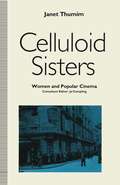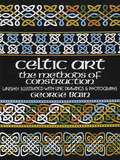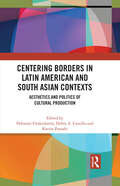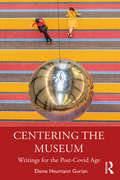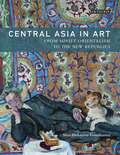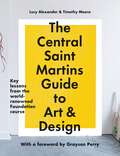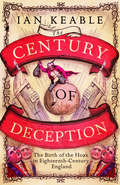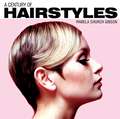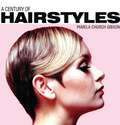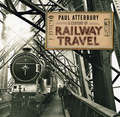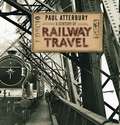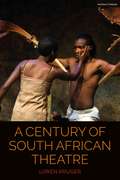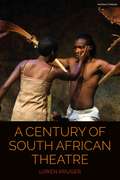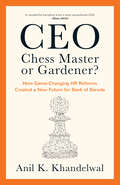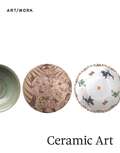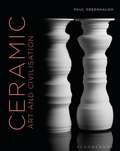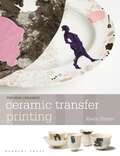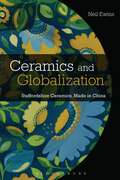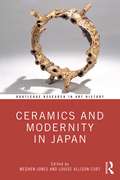- Table View
- List View
Celluloid Sisters: Women And Popular Cinema
by Janet ThumimTaking De Lauretis' proposition that popular cinema is a 'technology of gender' the book explores the representation of women and the readerly activity of female audience members in respect of a group of eighteen films successful at the British box office between 1945 and 1965. A method for the analysis of fictional characters is presented and the discursive context within which contemporary meanings were formed is explored through reference to the press, particularly that addressed to a female readership.
Celtic Art: The Methods of Construction
by George BainThe construction principles of Celtic art were re-discovered in the middle of the 20th century by George Bain. Until his writing, the intricate knots, interlacings, and spirals used in illuminating The Book of Kells and in decorating craftwork and jewelry seemed almost impossible, "the work of angels." In this pioneering work, George Bain shows how simple principles, no more difficult than those used in needlecraft, were used to create some of the finest artistic works ever seen. He also explains how you can use these principles in re-creating artifacts and in creating your own Celtic designs for art and craft work or even for recreational use.Step-by-step procedures carefully introduce the simple rules and methods of Celtic knot work and the well-known designs from the great manuscripts and stone work. Later chapters build up to complex knot work, spiral work, and key pattern designs, with special coverage of alphabets and the stylized use of animals, humans, and plants. Altogether over 225 different patterns are presented for your use, with hundreds of modification suggestions, 110 historical and modern artifacts showing designs in use, a great number of letters including six complete alphabets and 25 decorative initials, and a number of animal and human figures used in the original Celtic works.Artists, students, craftspeople, even children can work with these patterns and instructions for creating dynamic designs for use in leather work, in embroidery and other needle work, in metalwork, jewelry making, card design, borders, panels, illuminations, and in countless other ways. Mathematicians will find a great deal of pleasure in the geometric principles on which the patterns are based. Art historians and others interested in studying Celtic art will find a great number of outstanding art works and the best presentation in English for understanding Celtic design.
Centering Borders in Latin American and South Asian Contexts: Aesthetics and Politics of Cultural Production
by Debaroti ChakrabortyThis book presents inter-disciplinary research on contemporary borders with contributions from scholars and cultural practitioners located in different contexts in the Americas and South Asia. There has been significant sociological work on borders; however there is a relative dearth of humanities research on contemporary border realities, particularly in South Asia. This volume introduces frameworks of critical insights and knowledge on border narratives and cultural productions. It addresses and goes beyond the impact of the partition in South Asia to train a unique comparative and aesthetic lens on borders and borderlands in relation to Latin America and the U.S.A. through oral narratives, photographs, ‘objects’, films, theatre, journals, and songs. It maps border perspectives and their reception in a framework of cultural politics. It revolves around themes such as violence and modes of survival; women’s narratives of migration, trafficking and incarceration; abduction of children; vulnerability as experience; rationalities of mass killings; and proliferation of countercultures to map border perspectives in a framework of cultural politics. First of its kind, the volume will be useful to scholars and researchers of comparative literary and cultural studies, South Asian studies, Latin American studies, border studies, arts and aesthetics, visual studies, sociology, comparative politics, international relations, and peace and conflict resolution studies.
Centering Borders in Latin American and South Asian Contexts: Aesthetics and Politics of Cultural Production
by Debaroti Chakraborty Debra A. Castillo Kavita PanjabiThis book presents inter-disciplinary research on contemporary borders with contributions from scholars and cultural practitioners located in different contexts in the Americas and South Asia. There has been significant sociological work on borders; however there is a relative dearth of humanities research on contemporary border realities, particularly in South Asia. This volume introduces frameworks of critical insights and knowledge on border narratives and cultural productions. It addresses and goes beyond the impact of the partition in South Asia to train a unique comparative and aesthetic lens on borders and borderlands in relation to Latin America and the U.S.A. through oral narratives, photographs, ‘objects’, films, theatre, journals, and songs. It maps border perspectives and their reception in a framework of cultural politics. It revolves around themes such as violence and modes of survival; women’s narratives of migration, trafficking and incarceration; abduction of children; vulnerability as experience; rationalities of mass killings; and proliferation of countercultures to map border perspectives in a framework of cultural politics. First of its kind, the volume will be useful to scholars and researchers of comparative literary and cultural studies, South Asian studies, Latin American studies, border studies, arts and aesthetics, visual studies, sociology, comparative politics, international relations, and peace and conflict resolution studies.
Centering the Museum: Writings for the Post-Covid Age
by Elaine Heumann GurianDrawing on Elaine Heumann Gurian’s fifty years of museum experience, Centering the Museum calls on the profession to help visitors experience their shared humanity and find social uses for public buildings, in order to make museums more central and useful to everyone in difficult times. Following the same format as Civilizing the Museum, this new volume includes material written especially for a re-emergent time and relevant public lectures not included in the author’s previous book. Divided into six separate content clusters, with over twenty different essays, the book identifies many small, subtle ways museums can become welcoming to more—and to all. Drawing on her extensive experience as a deputy director, senior advisor to high-profile government museums, lecturer and teacher around the world, the author provides recommendations for inclusive actions by intertwining sociological thinking with practical decision-making strategies. Writing reflectively, Elaine also provides heritage students and professionals with insights that will help move their careers and organizations into more equitable, yet successful, terrain. Centering the Museum will be an excellent companion volume to Civilizing the Museum and, as such, will be a useful support for emerging museum leaders. It will be especially interesting to academics and students engaged in the study of cultural administration, as well as museum and heritage practitioners working around the world.
Centering the Museum: Writings for the Post-Covid Age
by Elaine Heumann GurianDrawing on Elaine Heumann Gurian’s fifty years of museum experience, Centering the Museum calls on the profession to help visitors experience their shared humanity and find social uses for public buildings, in order to make museums more central and useful to everyone in difficult times. Following the same format as Civilizing the Museum, this new volume includes material written especially for a re-emergent time and relevant public lectures not included in the author’s previous book. Divided into six separate content clusters, with over twenty different essays, the book identifies many small, subtle ways museums can become welcoming to more—and to all. Drawing on her extensive experience as a deputy director, senior advisor to high-profile government museums, lecturer and teacher around the world, the author provides recommendations for inclusive actions by intertwining sociological thinking with practical decision-making strategies. Writing reflectively, Elaine also provides heritage students and professionals with insights that will help move their careers and organizations into more equitable, yet successful, terrain. Centering the Museum will be an excellent companion volume to Civilizing the Museum and, as such, will be a useful support for emerging museum leaders. It will be especially interesting to academics and students engaged in the study of cultural administration, as well as museum and heritage practitioners working around the world.
Central Asia in Art: From Soviet Orientalism to the New Republics
by Aliya Abykayeva-TiesenhausenIn the midst of the space race and nuclear age, Soviet Realist artists were producing figurative oil paintings. Why? How was art produced to control and co-opt the peripheries of the Soviet Union, particularly Central Asia? Presenting the 'untold story' of Soviet Orientalism, Aliya Abykayeva-Tiesenhausen re-evaluates the imperial project of the Soviet state, placing the Orientalist undercurrent found within art and propaganda production in the USSR alongside the creation of new art forms in Kazakhstan, Kyrgyzstan and Uzbekistan. From the turmoil of the 1930s through to the post-Stalinist era, the author draws on meticulous new research and rich illustrations to examine the political and social structures in the Soviet Union - and particularly Soviet Central Asia - to establish vital connections between Socialist Realist visual art, the creation of Soviet identity and later nationalist sentiments.
Central Saint Martins Foundation: Key lessons in art and design
by Lucy Alexander Timothy Meara Central Saint MartinsExplore and expand your creative skill set with The Central Saint Martins Guide to Art & Design, fully updated in 2023 in line with the current course, with a new afterword by Rathna Ramanathan, Head of Central Saint Martins.Guided by key lessons from college tutors, you'll learn to expand your creative abilities and develop your own visual language. Exclusive projects from the world-class Central Saint Martins Foundation Diploma in Art and Design will inspire your experiments and unlock your potential across four key areas: communication design, fashion and textiles, fine art and three-dimensional design. No matter which discipline you choose to pursue, this book will help you discover who you want to be and set you on the path to achieving it.'Do you care about heartbreaking beauty, fresh new ideas, astounding craftsmanship, ingenious solutions, the tingle of a shocking image? Would you make art even if it wasn't your job? Then this is the book for you' - Grayson Perry
The Century of Deception: The Birth of the Hoax in Eighteenth-Century England
by Ian Keable‘Utter joy! A delicious romp through the heyday of balderdash and grand-scale deception, penned by one of the country’s finest magical minds.’ Derren BrownIn 1749, a newspaper advertisement appeared declaring that a man would climb inside a bottle on the stage of a London theatre. Although the crowds turned up in their hundreds to witness the trick, the performer didn’t. Over the following decades, elaborate pranks would continue to bamboozle audiences across England.In The Century of Deception, magician and magic historian Ian Keable tells the engrossing stories of these eighteenth-century hoaxes and those who were duped by them. The English public were hoodwinked time and time again, swallowing whole tales of rapping ghosts, a woman who gave birth to rabbits, a levitating Frenchman in a Chinese Temple and outrageous astrological predictions. Not only were the hoaxes widely influential, drawing in celebrities such as Samuel Johnson, Benjamin Franklin and Jonathan Swift, they also inflamed concerns about ‛English credulity’.‘Fake news’ and ‛going viral’ may be modern terms, but as this entertaining, eye-opening book shows, these concepts have been with us for centuries. ‘A fascinating, witty and beautifully-written book.’ Matt Lucas ‘Ian Keable’s brilliant book has opened my eyes to an incredible world of hoaxers and deceivers that I didn’t know even existed. A cracking read filled with extraordinary stories.’ Andy Nyman 'A masterful and fascinating journey into a hitherto hidden world of history, mystery and hoaxes.' Richard Wiseman
A Century of Hairstyles (Century Of Ser.)
by Pamela Church GibsonNothing defines a person like their hairstyle – and what a century it has been for hair! Bangs, bobs, buns, beehives and bouffants have vied with pixie cuts, pin curls, perms and pageboys for ascendancy in an ever-changing parade of ladies' looks and trends, and amongst the men we've seen caesers, comb overs, ducktails, faux hawks, flattops, quiffs and slick backs. From the Edwardian era through the seismic changes of the 1920s and '60s, and including every quirky twist hair history took on its way to the turn of the millennium, this book is a lush visual survey of a hundred years of hairstyles.
A Century of Hairstyles (Century Of)
by Pamela Church GibsonNothing defines a person like their hairstyle – and what a century it has been for hair! Bangs, bobs, buns, beehives and bouffants have vied with pixie cuts, pin curls, perms and pageboys for ascendancy in an ever-changing parade of ladies' looks and trends, and amongst the men we've seen caesers, comb overs, ducktails, faux hawks, flattops, quiffs and slick backs. From the Edwardian era through the seismic changes of the 1920s and '60s, and including every quirky twist hair history took on its way to the turn of the millennium, this book is a lush visual survey of a hundred years of hairstyles.
A Century of Railway Travel (Century Of Ser.)
by Paul AtterburyFrom the Edwardian golden age of steam to the present, the railway has captured the hearts and imaginations of the British people like no other mode of travel. In wartime and peace, along major routes and minor, steam, diesel and electric trains have carried commuters to work, families to holiday destinations and provided the means to myriad other adventures – the train a constant presence in an ever-changing way of life. A Century of Railway Travel presents one hundred years of the British passenger's story, using striking full-page imagery with commentary from bestselling author Paul Atterbury. From the open platforms of provincial stations before the First World War to the modern throngs at Waterloo on Derby Day, and from compartments that separated rich from poor and male from female, to the rise to dominance of modern standard class, this book depicts the rich tapestry of progress and heritage that has been the last century of British train travel. The coloured card ticket in your hand, the rough feel of the upholstered seats, and the call of the whistle, the scenery begins to move across the carriage windows of one of Britain's great steam-trains: with full-page illustrations and text alive with insight and nostalgia, this is a passenger's history of train travel in the last century.
A Century of Railway Travel (Century Of)
by Paul AtterburyFrom the Edwardian golden age of steam to the present, the railway has captured the hearts and imaginations of the British people like no other mode of travel. In wartime and peace, along major routes and minor, steam, diesel and electric trains have carried commuters to work, families to holiday destinations and provided the means to myriad other adventures – the train a constant presence in an ever-changing way of life. A Century of Railway Travel presents one hundred years of the British passenger's story, using striking full-page imagery with commentary from bestselling author Paul Atterbury. From the open platforms of provincial stations before the First World War to the modern throngs at Waterloo on Derby Day, and from compartments that separated rich from poor and male from female, to the rise to dominance of modern standard class, this book depicts the rich tapestry of progress and heritage that has been the last century of British train travel. The coloured card ticket in your hand, the rough feel of the upholstered seats, and the call of the whistle, the scenery begins to move across the carriage windows of one of Britain's great steam-trains: with full-page illustrations and text alive with insight and nostalgia, this is a passenger's history of train travel in the last century.
A Century of South African Theatre (Cultural Histories of Theatre and Performance)
by Loren Kruger“Theatre is not part of our vocabulary”: Sipho Sepamla's provocation in 1981, the year of famous anti-apartheid play Woza Albert!, prompts the response, yes indeed, it is. A Century of South African Theatre demonstrates the impact of theatre and other performances-pageants, concerts, sketches, workshops, and performance art-over the last hundred years. Its coverage includes African responses to pro-British pageants celebrating white Union in 1910, such as the Emancipation Centenary of the abolition of British colonial slavery in 1934 organized by Griffiths Motsieloa and HIE Dhlomo, through anti-apartheid testimonial theatre by Athol Fugard, Maishe Maponya, Gcina Mhlophe, and many others, right up to the present dramatization of state capture, inequality and state violence in today's unevenly democratic society, where government has promised much but delivered little. Building on Loren Kruger's personal observations of forty years as well as her published research, A Century of South African Theatre provides theoretical coordinates from institution to public sphere to syncretism in performance in order to highlight South Africa's changing engagement with the world from the days of Empire, through the apartheid era to the multi-lateral and multi-lingual networks of the 21st century. The final chapters use the Constitution's injunction to improve wellbeing as a prompt to examine the dramaturgy of new problems, especially AIDS and domestic violence, as well as the better known performances in and around the Truth and Reconciliation Commission. Kruger critically evaluates internationally known theatre makers, including the signature collaborations between animator/designer William Kentridge, and Handspring Puppet Company, and highlights the local and transnational impact of major post-apartheid companies such as Magnet Theatre.
A Century of South African Theatre (Cultural Histories of Theatre and Performance)
by Loren Kruger“Theatre is not part of our vocabulary”: Sipho Sepamla's provocation in 1981, the year of famous anti-apartheid play Woza Albert!, prompts the response, yes indeed, it is. A Century of South African Theatre demonstrates the impact of theatre and other performances-pageants, concerts, sketches, workshops, and performance art-over the last hundred years. Its coverage includes African responses to pro-British pageants celebrating white Union in 1910, such as the Emancipation Centenary of the abolition of British colonial slavery in 1934 organized by Griffiths Motsieloa and HIE Dhlomo, through anti-apartheid testimonial theatre by Athol Fugard, Maishe Maponya, Gcina Mhlophe, and many others, right up to the present dramatization of state capture, inequality and state violence in today's unevenly democratic society, where government has promised much but delivered little. Building on Loren Kruger's personal observations of forty years as well as her published research, A Century of South African Theatre provides theoretical coordinates from institution to public sphere to syncretism in performance in order to highlight South Africa's changing engagement with the world from the days of Empire, through the apartheid era to the multi-lateral and multi-lingual networks of the 21st century. The final chapters use the Constitution's injunction to improve wellbeing as a prompt to examine the dramaturgy of new problems, especially AIDS and domestic violence, as well as the better known performances in and around the Truth and Reconciliation Commission. Kruger critically evaluates internationally known theatre makers, including the signature collaborations between animator/designer William Kentridge, and Handspring Puppet Company, and highlights the local and transnational impact of major post-apartheid companies such as Magnet Theatre.
CEO—Chess Master or Gardener?: How Game-Changing HR Reforms Created a New Future for Bank of Baroda
by Anil K. KhandelwalMany problems of public sector banks in India are rooted in the legacy-driven culture of industrial relations (IR) and human resource (HR) management. These have inhibited the pace of internal reforms. This book presents ways in which the author, in his role as a CEO, and using insights gained during field research, undertook creative destruction of the legacy culture in IR/HR in Bank of Baroda. This was done through multiple initiatives, including reordering the pattern of IR management and game-changing innovations in employee engagement, eventually transforming the organisation into a valuable brand. The book illustrates the strategic role of CEOs in designing a new future for their organisations in the face of multiple challenges through harmonising the HR function with business. It also provides several insightful leadership lessons to top managements of large organisations to move from a narrowly focused HR culture to a broader HR paradigm consistent with the requirements of a competitive landscape.
Ceramic Art (ART/WORK)
by Margaret S. Graves Sequoia Miller Magdalene Odundo Vicki ParryA new examination of the history of ceramic art, spanning ancient to modern times, emphasizing its traditions, materials, and methods of makingConcise but comprehensive, Ceramic Art brings together the voices of art historians, conservators, and artists to tell the history of making art from fired clay. The story spans history and continents, examining the global traditions of ceramists that range from pre-Columbian Peruvian artisans to contemporary African studio potters.The volume shows how human need gave rise to multiple traditions in earthenware, stoneware, porcelain, glaze, and surface decoration from Africa, Asia, Europe, the Middle East, and the Americas. Essays describe the core materials and practice of ceramics, followed by consideration of its production, consumption, and use. Throughout, the focus is on the power of materials and the role conservation plays in the afterlife of a ceramic object.An accessible introduction to an ancient practice, Ceramic Art offers new ways of thinking about the broader forces that have shaped the traditions of the medium.
Ceramic, Art and Civilisation
by Paul GreenhalghIn his major new history, Paul Greenhalgh tells the story of ceramics as a story of human civilisation, from the Ancient Greeks to the present day. As a core craft technology, pottery has underpinned domesticity, business, religion, recreation, architecture, and art for millennia. Indeed, the history of ceramics parallels the development of human society.This fascinating and very human history traces the story of ceramic art and industry from the Ancient Greeks to the Romans and the medieval world; Islamic ceramic cultures and their influence on the Italian Renaissance; Chinese and European porcelain production; modernity and Art Nouveau; the rise of the studio potter, Art Deco, International Style and Mid-Century Modern, and finally, the contemporary explosion of ceramic making and the postmodern potter. Interwoven in this journey through time and place is the story of the pots themselves, the culture of the ceramics, and their character and meaning. Ceramics have had a presence in virtually every country and historical period, and have worked as a commodity servicing every social class. They are omnipresent: a ubiquitous art. Ceramic culture is a clear, unique, definable thing, and has an internal logic that holds it together through millennia. Hence ceramics is the most peculiar and extraordinary of all the arts. At once cheap, expensive, elite, plebeian, high-tech, low-tech, exotic, eccentric, comic, tragic, spiritual, and secular, it has revealed itself to be as fluid as the mud it is made from.Ceramics are the very stuff of how civilized life was, and is, led. This then is the story of human society's most surprising core causes and effects.
Ceramic, Art and Civilisation
by Paul GreenhalghIn his major new history, Paul Greenhalgh tells the story of ceramics as a story of human civilisation, from the Ancient Greeks to the present day. As a core craft technology, pottery has underpinned domesticity, business, religion, recreation, architecture, and art for millennia. Indeed, the history of ceramics parallels the development of human society.This fascinating and very human history traces the story of ceramic art and industry from the Ancient Greeks to the Romans and the medieval world; Islamic ceramic cultures and their influence on the Italian Renaissance; Chinese and European porcelain production; modernity and Art Nouveau; the rise of the studio potter, Art Deco, International Style and Mid-Century Modern, and finally, the contemporary explosion of ceramic making and the postmodern potter. Interwoven in this journey through time and place is the story of the pots themselves, the culture of the ceramics, and their character and meaning. Ceramics have had a presence in virtually every country and historical period, and have worked as a commodity servicing every social class. They are omnipresent: a ubiquitous art. Ceramic culture is a clear, unique, definable thing, and has an internal logic that holds it together through millennia. Hence ceramics is the most peculiar and extraordinary of all the arts. At once cheap, expensive, elite, plebeian, high-tech, low-tech, exotic, eccentric, comic, tragic, spiritual, and secular, it has revealed itself to be as fluid as the mud it is made from.Ceramics are the very stuff of how civilized life was, and is, led. This then is the story of human society's most surprising core causes and effects.
Ceramic Transfer Printing (New Ceramics)
by Kevin PetrieThe ultimate guide to the potential of ceramic transfer printing as a creative medium.This book is aimed at those in ceramics who wish to move into print and transfers, a very exciting area which has enormous scope for creativity. Ceramic transfers or decals are one of the prime methods of decorating industrially-made ceramics. They also offer exciting creative potential for studio-based artists or designer-makers. A ceramic transfer is traditionally made by printing ceramic ink onto a special paper and allows pictures, patterns or text to be transferred onto ceramic forms - 2D and 3D. Importantly, print can achieve distinct aesthetic effects on ceramics that are not possible by using other decoration methods such as hand painting. Drawing on over twenty years of experience, Kevin Petrie offers a focused analysis of the potential of ceramic transfer printing as a creative medium. The specific materials and techniques for making versatile screen-printed ceramic transfers are explained in detail - from the 'low tech' to the more sophisticated. Other approaches by artist researchers are also brought together in this book and recent developments with digital transfers appraised. A range of case studies shows the potential and diversity of approach in this area, which extends beyond ceramics to include printing on enamel, metal and glass.
Ceramic Transfer Printing (New Ceramics)
by Kevin PetrieThe ultimate guide to the potential of ceramic transfer printing as a creative medium.This book is aimed at those in ceramics who wish to move into print and transfers, a very exciting area which has enormous scope for creativity. Ceramic transfers or decals are one of the prime methods of decorating industrially-made ceramics. They also offer exciting creative potential for studio-based artists or designer-makers. A ceramic transfer is traditionally made by printing ceramic ink onto a special paper and allows pictures, patterns or text to be transferred onto ceramic forms - 2D and 3D. Importantly, print can achieve distinct aesthetic effects on ceramics that are not possible by using other decoration methods such as hand painting. Drawing on over twenty years of experience, Kevin Petrie offers a focused analysis of the potential of ceramic transfer printing as a creative medium. The specific materials and techniques for making versatile screen-printed ceramic transfers are explained in detail - from the 'low tech' to the more sophisticated. Other approaches by artist researchers are also brought together in this book and recent developments with digital transfers appraised. A range of case studies shows the potential and diversity of approach in this area, which extends beyond ceramics to include printing on enamel, metal and glass.
Ceramics and Globalization: Staffordshire Ceramics, Made in China
by Neil EwinsNeil Ewins' study of the Staffordshire potteries in a period of great global change traces how ceramics production has been affected by globalisation in both familiar and unexpected ways.Although many manufacturers such as Wedgwood initially moved production to cheaper labour markets in East Asia, others remained in or returned to England once it became clear that outsourcing manufacturing was affecting the brand value and customer perception of their products. Neil Ewins explores the complex behaviour of the UK ceramics industry, using a combination of evidence from the press, trade journals, ceramic objects, and primary interview evidence of manufacturers, retailers and a ceramic designer. Ewins suggests that, although the surface designs of UK ceramics invariably reflect diverse cultural and stylistic influences, a notion of authenticity often still resides in the place and context in which the ceramic product was originally made. Overall, the book argues that UK ceramics remain culturally complex because of issues of supply and demand, and ties to heritage, imagined or otherwise. Within a context of globalization, the book highlights compelling issues which have huge ramifications on UK manufacturing futures.
Ceramics and Globalization: Staffordshire Ceramics, Made in China
by Neil EwinsNeil Ewins' study of the Staffordshire potteries in a period of great global change traces how ceramics production has been affected by globalisation in both familiar and unexpected ways.Although many manufacturers such as Wedgwood initially moved production to cheaper labour markets in East Asia, others remained in or returned to England once it became clear that outsourcing manufacturing was affecting the brand value and customer perception of their products. Neil Ewins explores the complex behaviour of the UK ceramics industry, using a combination of evidence from the press, trade journals, ceramic objects, and primary interview evidence of manufacturers, retailers and a ceramic designer. Ewins suggests that, although the surface designs of UK ceramics invariably reflect diverse cultural and stylistic influences, a notion of authenticity often still resides in the place and context in which the ceramic product was originally made. Overall, the book argues that UK ceramics remain culturally complex because of issues of supply and demand, and ties to heritage, imagined or otherwise. Within a context of globalization, the book highlights compelling issues which have huge ramifications on UK manufacturing futures.
Ceramics and Modernity in Japan (Routledge Research in Art History)
by Meghen M. Jones Louise Allison CortCeramics and Modernity in Japan offers a set of critical perspectives on the creation, patronage, circulation, and preservation of ceramics during Japan’s most dramatic period of modernization, the 1860s to 1960s. As in other parts of the world, ceramics in modern Japan developed along the three ontological trajectories of art, craft, and design. Yet, it is widely believed that no other modern nation was engaged with ceramics as much as Japan—a "potter’s paradise"—in terms of creation, exhibition, and discourse. This book explores how Japanese ceramics came to achieve such a status and why they were such significant forms of cultural production. Its medium-specific focus encourages examination of issues regarding materials and practices unique to ceramics, including their distinct role throughout Japanese cultural history. Going beyond descriptive historical treatments of ceramics as the products of individuals or particular styles, the closely intertwined chapters also probe the relationship between ceramics and modernity, including the ways in which ceramics in Japan were related to their counterparts in Asia and Europe. Featuring contributions by leading international specialists, this book will be useful to students and scholars of art history, design, and Japanese studies.
Ceramics and Modernity in Japan (Routledge Research in Art History)
by Meghen M. Jones Louise Allison CortCeramics and Modernity in Japan offers a set of critical perspectives on the creation, patronage, circulation, and preservation of ceramics during Japan’s most dramatic period of modernization, the 1860s to 1960s. As in other parts of the world, ceramics in modern Japan developed along the three ontological trajectories of art, craft, and design. Yet, it is widely believed that no other modern nation was engaged with ceramics as much as Japan—a "potter’s paradise"—in terms of creation, exhibition, and discourse. This book explores how Japanese ceramics came to achieve such a status and why they were such significant forms of cultural production. Its medium-specific focus encourages examination of issues regarding materials and practices unique to ceramics, including their distinct role throughout Japanese cultural history. Going beyond descriptive historical treatments of ceramics as the products of individuals or particular styles, the closely intertwined chapters also probe the relationship between ceramics and modernity, including the ways in which ceramics in Japan were related to their counterparts in Asia and Europe. Featuring contributions by leading international specialists, this book will be useful to students and scholars of art history, design, and Japanese studies.
